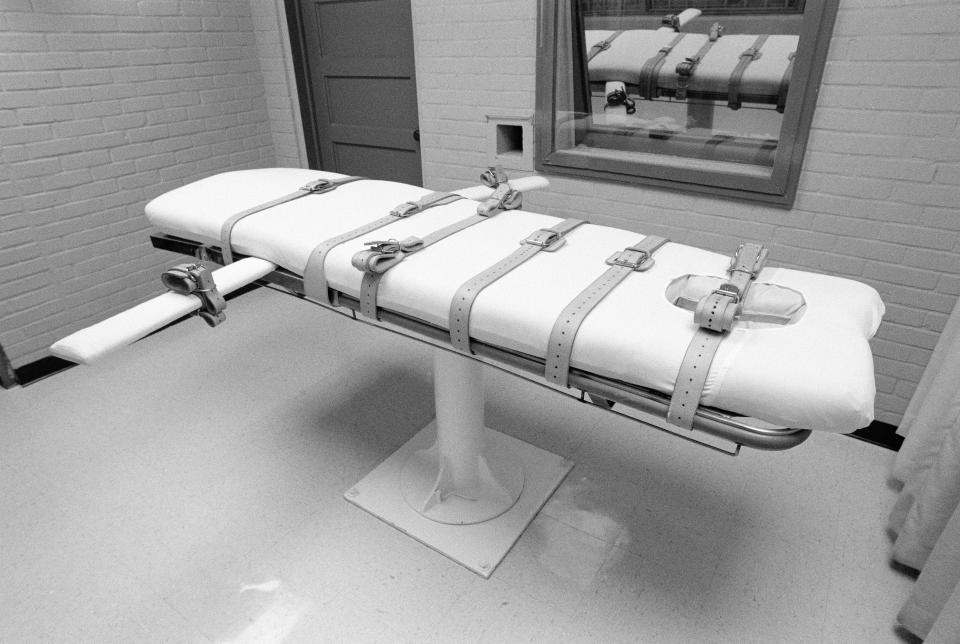Alabama Is Preparing To Execute People With Lethal Gas, As States Scramble To Find New Ways To Kill People

Earlier this month, the head of Alabama’s corrections department revealed in a court filing that the agency is “nearing completion of the initial physical build for the nitrogen hypoxia system.” In other words: It is almost ready to use lethal gas to execute people on the state’s death row.
Alabama is one of several states creating new — and untested — ways of legally killing people. In recent years, the drugs used to execute people by lethal injection have become both increasingly difficult to obtain and subject to legal scrutiny in the courts. States that are determined to continue applying capital punishment have therefore set out in search of new methods to end a human life, from firing squads to bringing back electric chairs to gas.
Alabama became the third state to legalize execution by nitrogen gas in 2018, a process in which the individual inhales nitrogen through a gas chamber or a gas mask and dies of asphyxiation. Until recently, this process was hypothetical. No state has ever executed a prisoner this way and even states that allow it haven’t had the capability to carry out such a killing.
Proponents of capital punishment claim the process will result in a fast, humane death. In fact, nitrogen hypoxia executions carry the same moral problems as other death penalty practices. There is no medical or scientific evidence to back the claim that any execution method is reliably painless. There probably never will be, because it is medically unethical for a doctor to study the best way to kill a person who does not want to die.
Instead, pro-death penalty politicians and policymakers with no medical expertise are pushing a killing technique they believe will both be logistically viable and appear humane, regardless of the suffering actually being experienced by the condemned. “It’s almost by definition an experimental process,” Robert Dunham, the executive director of the Death Penalty Information Center, told The Associated Press.
States began looking to nitrogen hypoxia as an alternative to lethal injection after Oklahoma’s high-profile botched execution of Clayton Lockett in 2014. Lockett writhed and groaned in apparent pain after being injected with an experimental combination of drugs. When it became clear the killing was not going as planned, executioners removed the needle from his body. The head of the state’s corrections department later told reporters that Lockett’s vein had exploded. Lockett died of a heart attack 43 minutes after the needle entered his body.
Lockett’s death, described by then-President Barack Obama as “deeply disturbing,” was followed by a moratorium on executions in Oklahoma. But death penalty enthusiasts were eager to find another way to resume the killings. Mike Christian, a Republican state representative at the time, had a plan.
According to The Appeal, Christian had watched a BBC documentary called “How To Kill a Human Being,” in which a former British conservative politician explores various methods of execution and declares a nitrogen mask “the perfect killing machine.” At Christian’s request, three people with no professional backgrounds in medicine compiled a 14-page report on the merits of nitrogen hypoxia as a form of capital punishment, citing The National Review and Slate as references. Christian, who had previously saidhe didn’t care if executioners used “lethal injection, the guillotine or if we feed them to the lions,” claimed in 2015 that “we have come up with a fool-proof way for a humane execution.”
In 2015, about a year after Lockett’s death, Oklahoma became the first state to authorize executions using nitrogen gas, followed soon after by Mississippi and Alabama. Since then, executions using lethal injection have only attracted more scrutiny. Autopsies of individuals who have been executed by lethal injection show evidence of pulmonary edema, a condition in which the lungs fill with fluid and create the painful sensation of suffocating or drowning. The federal government is facing ongoing litigation over the legality of its lethal injection protocol. Drug companies have become so wary of providing their products for use in the killings that the federal government recently bought the drugs from a secret pharmacy that failed a quality test.
Even getting the drugs into an individual’s bloodstream can be a torturous process. In 2018, an execution team in Alabama spent about two hours trying to inject a man named Doyle Lee Hamm, whose veins had been damaged by intravenous drug use and chemotherapy. The executioners eventually gave up, leaving Hamm urinating blood, potentially from a punctured bladder. The state said it would not try to kill Hamm again.
Although it is clear that lethal injection has not lived up to its promise as a humane method of execution, there is no evidence that nitrogen hypoxia would be a better alternative. The limited information that exists about the use of nitrogen as a killing agent comes from euthanizing some small animals, as well as from studying industrial accidents and suicides.
None of these situations resemble the conditions of an execution, in which an individual could hold their breath or otherwise try to fight for their life. The American Veterinary Medical Association said in its 2020 euthanasia guidelines that although hypoxia resulting from nitrogen exposure may be an acceptable way to kill chickens, turkeys, and pigs under certain conditions, it should not be used to kill other mammals. Rats who were exposed to high levels of nitrogen gas showed signs of “panic and distress” before they collapsed and died, the AVMA said.
The revelation that Alabama is actively preparing for executions using nitrogen came in response to a lawsuit from a man on the state’s death row named Charles Burton Jr. Burton, who is Muslim, sued the state’s corrections department in 2019 in an effort to compel the agency to provide for an imam to be present as his spiritual adviser in the event of his execution. In a June 8 status report, Department of Corrections Commissioner Jefferson Dunn told the court that the agency had not yet decided whether a spiritual adviser could safely be in the execution chamber alongside an individual being killed by nitrogen gas.
In addition to the three states that authorize nitrogen hypoxia as a method of execution, four other states allow the use of lethal gas to kill people on death row. Arizona is currently refurbishing its gas chamber to kill people using hydrogen cyanide, the same gas that Nazis used in its gas chambers in Auschwitz, the Guardian reported last month. The last time Arizona used cyanide gas in an execution, in 1999, the man, Walter LaGrand, choked and gagged for 18 minutes before he died.
This article originally appeared on HuffPost and has been updated.

 Yahoo Finance
Yahoo Finance 


